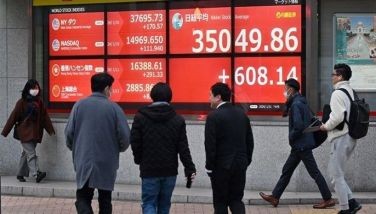Key policy rates unchanged, inflation forecast cut anew

MANILA, Philippines — The Bangko Sentral ng Pilipinas (BSP) decided yesterday to keep interest rates unchanged to allow the economy to absorb the effects of the previous rate hikes.
In a statement, BSP Governor Nestor Espenilla said the Monetary Board believes the prevailing monetary policy remains appropriate after the tightening episode that saw interest rates rise by a total of 175 basis points from May to November last year.
“Given these conditions, the Monetary Board deems the prevailing monetary policy settings to be appropriate, as previous monetary responses continue to work their way through the economy,” Espenilla said.
Espenilla said the risks to inflation outlook are seen to remain evenly balanced for 2019 while leaning toward the downside for 2020 due to a more uncertain global economic environment.
A weaker global economy, he explained, could temper potential upward pressures from commodity prices in the coming months.
Monetary authorities believe domestic demand conditions have remained firm, supported by a projected recovery in household spending as well as the sustained implementation of the government’s Build Build Build program.
Espenilla said price pressures continued to ease due to the decline in international crude oil prices as well as the normalization of supply conditions for key food items.
“The Monetary Board’s decision is based on its assessment of a more manageable inflation environment,” the BSP chief said.
Latest data showed inflation decelerated to a 10-month low of 4.4 percent in January from 5.1 percent in December. This was the slowest since inflation started breaching the BSP’s two to four percent target at 4.3 percent in March last year.
“So far, I think, we had a good head start. December was lower than expected, January was again much lower than expected. And these were two very important factors that drove the inflation process to start showing a more modest path through the end of 2019,” Guinigundo said.
Inflation accelerated to 5.2 percent last year from 2.9 percent in 2017 due to higher oil and food prices as well as weak peso. This paved the way for a series of rate hikes wherein benchmark rates were increased by 175 basis points in five straight rate-setting meetings from May to November last year,
“We always have to look at year-to-date plus the year-on-year on a monthly basis. That is how to read it more meaningfully so we get the big picture of the inflation dynamics that we are seeing today,” Guinigundo added.
BSP Assistant Governor Francisco Dakila said the Monetary Board slightly lowered its inflation forecast to 3.1 percent for this year but kept next year’s forecast at three percent.
ING Bank Manila senior economist Nicholas Mapa said the BSP continues to preach “data dependency” and may await further validation that inflation would settle within target as early as end of the first quarter before changing course.
“Given the supply-side nature of the recent inflation spike, we can expect price pressures to dissipate further even as the rice tarriffication bill remains unsigned and crude oil prices remain muted,” Mapa said.
BSP’s inflation forecasts, he added, validate that the BSP is likely done with its tightening cycle, with a policy reversal in sights given slowing growth momentum and inflation in-check.
He reiterated the BSP’s Monetary Board could resume slashing the reserve requirement ratio as early as February amid decelerating liquidity in the financial system.
“The BSP slammed on the brakes in 2018 given the hazard of second-round effects in full view. Now that the inflation threat appears safely in their rear view mirror we can see the central bank easing off the brake pedal ever so slightly by cutting rates in May after reducing RRR in the first quarter,” Mapa said.
- Latest
- Trending
































